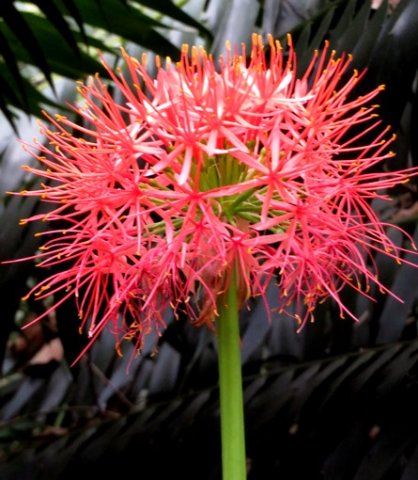Scadoxus multiflorus subsp. katharinae umbel

Author: Ivan Lätti
Photographer: Thabo Maphisa
In peak condition a Scadoxus multiflorus subsp. katharinae inflorescence may carry up to 150 flowers in the one spherical or hemispherical umbel grown per season from its rootstock. An umbel may reach 26 cm in diameter. The specific name, multiflorus, is apt, a Latin word meaning many-flowered.
The pinkish, pale to deep orange or orange-red flower colour is present upon both the six spreading, linear tepals and the six filaments of the stamens. The in-your-face protrusion of yellow anthers maximises the chances of loading pollen upon visiting insects.
These hungry visitors, like their ancestors over untold generations, fulfil an ecology-sustaining function by merely brushing pollen off on stigmas of more flowers of the same species as they go.
What are the chances of this happening correctly, performed by such a motley crowd of would-be transportation agents? They are after all uninformed recruits, unaware, their attention elsewhere, singularly bent upon filling their stomachs.
The answer: good to excellent in millions of cases! This is judged by ubiquitous flower and insect survival (in a world unaffected by human intervention). Millions of anthers provide, stigmas receive and insects go to sleep well fed, albeit sometimes inside the stomachs of bigger beasties that swallowed them whole, so their sleep is the sleep of the dead.
Factory managers would agonise over the product wastage and inefficiencies of such a system. Nature doesn’t. It doesn’t appoint factory managers. It makes do very well. For self-correction has been proven in nature; all failures dead and turned into food in some form.
Flowerheads of this Scadoxus last up to two weeks during bloomtime in late summer to early autumn. They provide ample opportunity for dinner guests to come calling. Diners that last longer than this blooming season adapt to varying their diets, or fulfil their life missions before famine sets in.
Successful pollination in this plant is marked by the swelling of the pedicel tips of the flowers. This is where the inferior ovaries grow the seeds (Duncan, et al, 2016).

